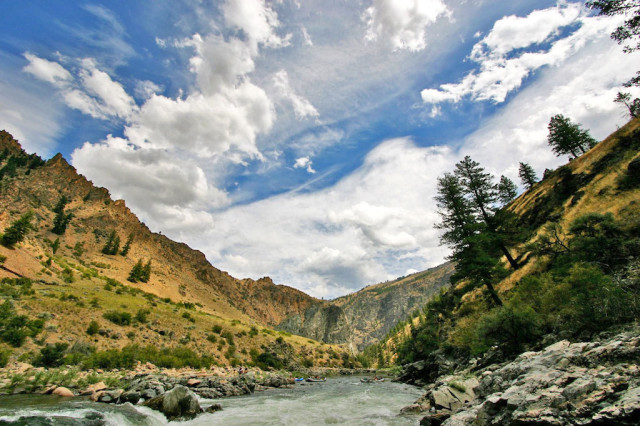About the Act
By the 1960s, it was becoming clear that our national policies and attitudes towards rivers were creating a crisis. Rivers were being dammed, dredged, diked, diverted and degraded at an alarming rate. To lend balance to our history of physically altering our waterways, Congress created the National Wild and Scenic Rivers System. In October of 1968, the Wild and Scenic Rivers Act pronounced,
'It is hereby declared to be the policy of the United States that certain selected rivers of the Nation which, with their immediate environments, possess outstandingly remarkable scenic, recreational, geologic, fish and wildlife, historic, cultural or other similar values, shall be preserved in free-flowing condition, and that they and their immediate environments shall be protected for the benefit and enjoyment of present and future generations.'

The Wild and Scenic Middle Fork of the Salmon River
The Wild and Scenic Rivers Act remains the strongest tool to protect river ecosystems in the country. Some of the nation’s premier rivers are protected for the benefit of future generations through their Wild and Scenic designations. The National Wild and Scenic Rivers System now protects many of the rivers of our history, our literature, our nation's youth. John Muir's Tuolumne River and his famous, losing battle to stop the flooding of Hetch Hetchy Valley; the Delaware River of the American Revolution; Zane Grey's famous flyfishing river, the North Umpqua; the Missouri of Lewis and Clark's journeys.
"In a country where nature has been so lavish and we have been so spendthrift of indigenous beauty, to set aside a few rivers in their natural state should be considered an obligation."
- Senator Frank Church
As you might guess, a large percentage of Wild and Scenic rivers flow through the Northwest. Oregon has the most rivers designated: 47; including the spectacular Klamath River and its incredible abundance of wildlife, which was added to the Wild and Scenic Rivers System following a 15-year battle over the proposed Salt Caves Hydroelectric Project. Alaska has the most miles designated: 3,210; including such rivers of the imagination as the Yukon. Idaho has some of our most celebrated wild rivers: Salmon, Snake and Selway among others. Our northwest states contribute well over half of the rivers in the National Wild and Scenic Rivers System. And there exists the potential for other rivers to be designated: the last section of the Columbia River in Washington not lying behind federal and private dams is eligible for designation. (Curiously enough, this reach is eligible because it has lain protected within the Hanford Nuclear Reservation, the site of Cold War atomic bomb production.)

The Wild and Scenic Rogue River
But not all Wild and Scenic rivers flow through the wildernesses of Alaska and the Northwest. Incredible fishing awaits anglers on Michigan's AuSable and Pere Marquette Rivers. The beauty of New England is reflected in the waters of Connecticut's Farmington River. The mysteries of the southern swamps call to paddlers in the Saline Bayou of Louisiana. Traces of Appalachia hold our imagination along West Virginia's Bluestone River. Our desire, our need to preserve our Revolutionary history helped lead to our adding Massachusetts' Concord, Sudbury and Assebet Rivers to the National System. And just recently, the National System was extended beyond the states to include three exotic rivers in the rain forests of Puerto Rico. These past designations reflect the diversity of the National Wild and Scenic Rivers System.
The Wild and Scenic Rivers Act includes a built-in flexibility that allows for it to meet diverse river conservation needs. Designation as a Wild and Scenic river does not 'lock it up.' The idea behind the National System is not to halt use of a river; instead, the goal is to preserve the character of a river. Uses compatible with the management goals of a particular river are allowed; change is expected to happen. However, development must ensure the river's free flow and protect its 'outstandingly remarkable resources.' The intent of Congress was to create a national system of protected rivers that co-existed with use and appropriate development. But the bottom line is that the National Wild and Scenic Rivers System is not something to be feared by landowners and in fact is frequently sought after to preserve quality of life and property values.
